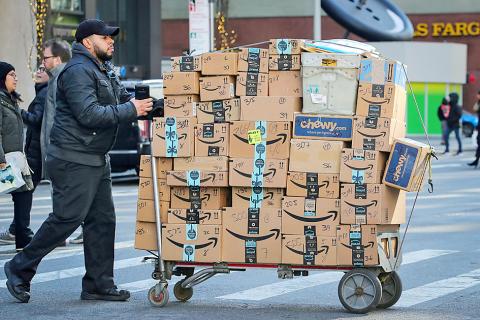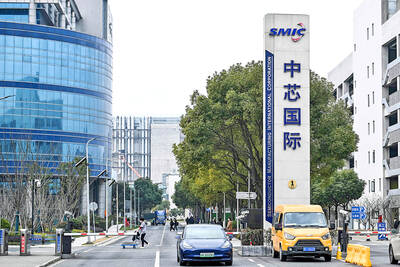Amazon.com Inc’s efforts to get packages from warehouse to doorstep in a single day helped push the retail giant to its first year-on-year quarterly profit decline since early 2017 and the spending binge is not over.
Amazon chief financial officer Brian Olsavsky on Thursday said that the costs of the company’s one-day delivery push would be about US$1.5 billion during the fourth quarter.
Amazon’s forecasts for operating income and sales in the period fell short of analysts’ estimates and its shares slumped as much as 9.1 percent in extended trading.

Photo: Reuters
Amazon chief executive Jeff Bezos has promised since the company’s initial public offering to invest for the long haul and he is proving again his willingness to endure a little short-term pain in a bid to expand.
Facing slowing growth in its core e-commerce business, Amazon in April announced an initiative to cut the delivery window on millions of items for paying members of its Prime subscription program.
That has helped reinvigorate sales, if at a high price.
“Customers love the transition of Prime from two days to one day — they’ve already ordered billions of items with free one-day delivery this year,” Bezos said in a statement. “It’s a big investment and it’s the right long-term decision for customers.”
The investments taking place across Amazon’s warehouses are “strategically necessary,” but they “continued to weigh heavily” on the profitability of the retail business, Moody’s Investors Service analyst Charlie O’Shea said.
Third-quarter net income narrowed to US$2.13 billion, or earnings per share of US$4.23, from US$2.88 billion, or US$5.75, a year earlier, the Seattle-based company said in the statement.
It was the first year-on-year decline since the second quarter of 2017.
Analysts, on average, forecast earnings per share of US$4.59, data compiled by Bloomberg showed.
Amazon forecast operating income of between US$1.2 billion and US$2.9 billion in the fourth quarter compared with analysts’ estimates of US$4.31 billion.
Sales would be US$80 billion to US$86.5 billion in the holiday period, the company said. Analysts forecast US$87.2 billion.
Operating expenses during the third quarter climbed 26 percent, the steepest rise in more than a year, to US$66.8 billion. Shipping costs soared 46 percent to US$9.6 billion.
Delivery is hardly the only place Amazon is investing.
Amazon’s costs for technology and content — largely salaries related to employees in research and development, as well as infrastructure for Amazon Web Services (AWS) Inc data centers — jumped 28 percent to US$9.2 billion.
The company’s total workforce increased 22 percent to 750,000.
While the shares have gained 19 percent this year to close at US$1,780.78 in New York on Thursday, they have fallen 12 percent since the July 15 high of US$2,020.99.
Investors had bid up Amazon shares on growing profits driven by AWS, services for third-party sellers and advertising.
The cloud-computing unit remains Amazon’s cash cow.
Sales rose 35 percent to about US$9 billion in the third quarter. The unit’s operating income, US$2.26 billion, accounted for more than two-thirds of the total.
However, growth at AWS was the slowest since Amazon began breaking out the unit’s performance.
That is “absolutely” a concern for investors, D.A. Davidson & Co analyst Tom Forte said.
Amazon, which had a lengthy head start in building out a cloud-computing platform, faces steep competition from well-funded rivals such as Microsoft Corp’s Azure and Google’s Cloud Platform.
“You’re seeing some incremental competitive pressure from Microsoft” in particular, Forte said.
Revenue gained 24 percent to US$70 billion in the third quarter. Analysts had forecast US$68.7 billion.

SEMICONDUCTOR SERVICES: A company executive said that Taiwanese firms must think about how to participate in global supply chains and lift their competitiveness Taiwan Semiconductor Manufacturing Co (TSMC, 台積電) yesterday said it expects to launch its first multifunctional service center in Pingtung County in the middle of 2027, in a bid to foster a resilient high-tech facility construction ecosystem. TSMC broached the idea of creating a center two or three years ago when it started building new manufacturing capacity in the US and Japan, the company said. The center, dubbed an “ecosystem park,” would assist local manufacturing facility construction partners to upgrade their capabilities and secure more deals from other global chipmakers such as Intel Corp, Micron Technology Inc and Infineon Technologies AG, TSMC said. It

NO BREAKTHROUGH? More substantial ‘deliverables,’ such as tariff reductions, would likely be saved for a meeting between Trump and Xi later this year, a trade expert said China launched two probes targeting the US semiconductor sector on Saturday ahead of talks between the two nations in Spain this week on trade, national security and the ownership of social media platform TikTok. China’s Ministry of Commerce announced an anti-dumping investigation into certain analog integrated circuits (ICs) imported from the US. The investigation is to target some commodity interface ICs and gate driver ICs, which are commonly made by US companies such as Texas Instruments Inc and ON Semiconductor Corp. The ministry also announced an anti-discrimination probe into US measures against China’s chip sector. US measures such as export curbs and tariffs

The US on Friday penalized two Chinese firms that acquired US chipmaking equipment for China’s top chipmaker, Semiconductor Manufacturing International Corp (SMIC, 中芯國際), including them among 32 entities that were added to the US Department of Commerce’s restricted trade list, a US government posting showed. Twenty-three of the 32 are in China. GMC Semiconductor Technology (Wuxi) Co (吉姆西半導體科技) and Jicun Semiconductor Technology (Shanghai) Co (吉存半導體科技) were placed on the list, formally known as the Entity List, for acquiring equipment for SMIC Northern Integrated Circuit Manufacturing (Beijing) Corp (中芯北方積體電路) and Semiconductor Manufacturing International (Beijing) Corp (中芯北京), the US Federal Register posting said. The

India’s ban of online money-based games could drive addicts to unregulated apps and offshore platforms that pose new financial and social risks, fantasy-sports gaming experts say. Indian Prime Minister Narendra Modi’s government banned real-money online games late last month, citing financial losses and addiction, leading to a shutdown of many apps offering paid fantasy cricket, rummy and poker games. “Many will move to offshore platforms, because of the addictive nature — they will find alternate means to get that dopamine hit,” said Viren Hemrajani, a Mumbai-based fantasy cricket analyst. “It [also] leads to fraud and scams, because everything is now